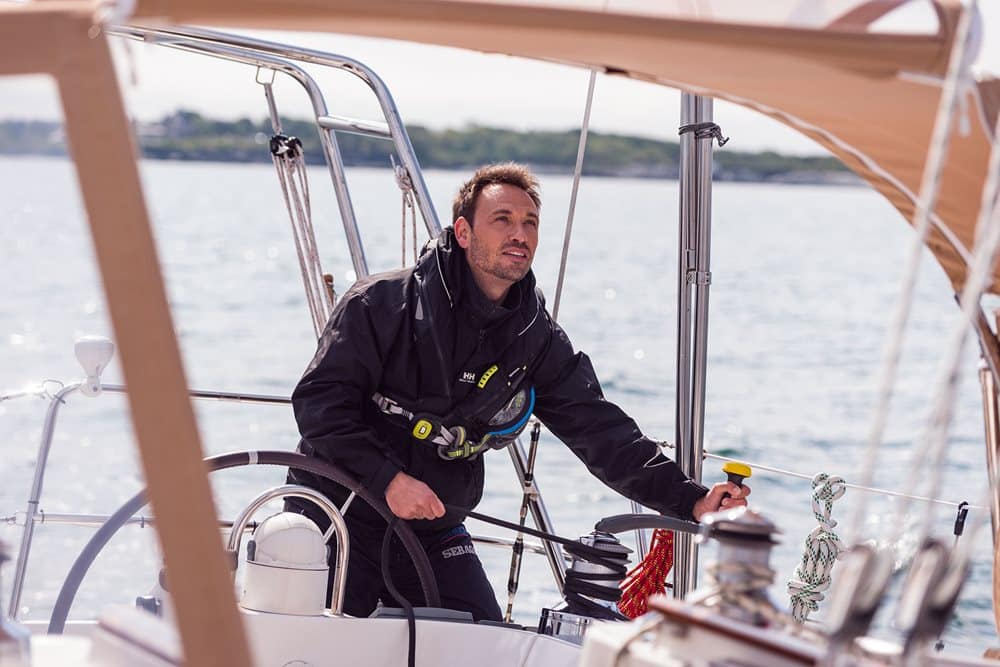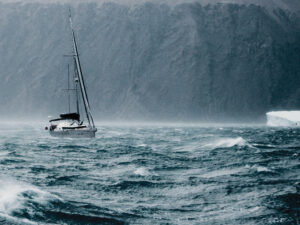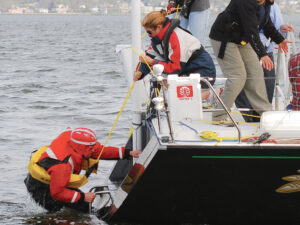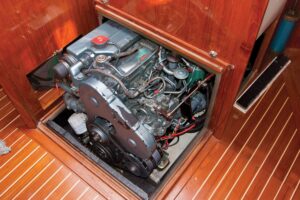
On November 6th of this year, 30 singlehanded sailors will set off on the most challenging sailing endeavor in the history of yacht racing; the Vendee Globe – a solo, around the world, non-stop marathon where no outside assistance is allowed. In the 27 years since the inception of this race, a total of 138 sailors have lined up on the starting line with only 71 finishing the course, the fastest being Francois Gabart in the last iteration, who managed to lap the planet in 78 days.
But singlehanded and shorthanded sailors aren’t all Vendee Globe racers with purpose built, ultra-high tech racing machines, the magic of being alone at sea is something that almost anyone can experience with a well-found vessel and the desire to venture out alone. Whether you’re racing or cruising, sailing shorthanded requires a change in the mindset of the individual as he or she takes on every role in the operation of the boat.
Boat setup and handling
Once the decision is made to sail shorthanded, the main thing to concentrate on is the ease of handling of your boat. You will be assuming all the roles: skipper, dial trimmer, navigator, bow-person, engineer and chef. The ultimate goal is to make each of these positions as simple for yourself as possible. One of the best ways to figure out where to begin this process is to go out on your boat on a calm day and go through the motions of sailing the boat as if you were racing or cruising; hoisting sails, steering, trimming and navigating and see where you run into problems. Can you reef your mainsail by yourself? Is the spinnaker pole too much to handle on your own? Can you reach the sheeting positions from the helm?
Generally speaking, if you’ve never gone out shorthanded before, this first outing may be a disaster. Simple things – like not being able to reach the main traveler while you’re steering – can be very problematic when you’re by yourself, so take notes as you flail around and start investigating ways to make your life simpler.
These changes may be as simple as moving a halyard clutch or two or a little more involved such as converting to a single-line reefing system; the goal throughout should be to make the boat easier to sail. Your local loft can also help you with this list and ideas how to best solve the problems and set the boat up for solo sailing.
Hardware
Because of the rising popularity of shorthanded racing and cruising, there has been a trickle-down effect in the technology used by Vendee Globe sailors. Equipment manufacturers now offer less expensive products based on the effectiveness of the prototypes used at the highest levels. Roller furling headsails and canting keels are both examples of how the evolution of shorthanded racing tech has filtered its way into the mainstream. More robust and reliable autopilots and sail handling systems are now available to the general public. Think through the experience you’re looking for, as well as your budget, to prioritize a hardware and equipment list. Again, consult your local loft with this list, they will have good recommendations and access to many industry partners to help you get exactly what you’re looking for.
Safety and communication
Sailing without a full complement of crew creates serious safety considerations that must be taken into account. There is always increased risk involved with fewer hands than normal on board whether it’s a solo weekend trip or a solo ocean crossing. Jacklines (stout webbing straps running bow to stern that are clipped into the tether on your harness) should always be in place and used even in the calmest weather. The advice “One hand for you, one hand for the boat” should be followed to the letter. It’s also important to make sure you have the appropriate life preserver for the conditions and events. This might involve investing in a few designs for different circumstances and weather. There are pros and cons to the different styles of deck vests, so do your research and consult a specialist to decide which ones will be right for you.
You will also want to create a sail and communication plan and share it with a trusted contact on shore. A sail plan should include a rough estimate of where you plan to sail along with an estimated time line. It should also include a communication and check-in plan, as well as an agreed upon course of action should you fail to check in. Onboard wifi and satellite phones, while more expensive, are reliable methods of communications if you’ll be far offshore, otherwise, a trusty cell phone can do the trick (Just make sure you have battery!)
Before venturing out, consider attending one of the Cruising Club of America’s Safety at Sea Seminars (a requirement for many popular offshore races such as Newport-Bermuda or the Transpac) where you will learn about the basics you’ll need for staying safe offshore.
Going solo doesn’t mean going alone
Finally, one major misconception about singlehanded and shorthanded sailors is that they’re introverted loners who go it alone for a variety of escapist reasons when in truth, you would be hard pressed to find a more supportive and engaging group of men and women who are always happy to share their knowledge with newcomers. Getting involved with local shorthanded sailing clubs like the P.S.S.A. on the west coast and the Bermuda 1-2 community in the northeast is a great way to meet like-minded sailors and ease your way into this type of sailing.
Singlehanded and shorthanded sailing is a unique challenge that is not to be taken lightly but one that will push you as far as you are willing to go. For some, that could be a solo passage to Bermuda and for others it could be as simple as going for a daysail without any assistance. Whatever your motivation, it’s a special kind of sailing that can be highly addictive and extremely satisfying. Consider yourself warned.








